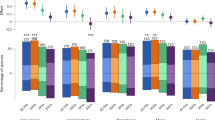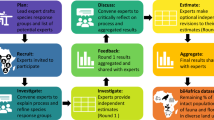Abstract
SPECIES conservation in situ requires networks of protected areas selected for high conservation interest1–3. Throughout most of the world, however, there are neither the resources nor the time to carry out detailed inventories for most taxa2,4 before designating protected areas. Site selection (on grounds other than availability) would be easier and more effective if two things were true: (1) habitats that are species-rich for one taxon are also species-rich for others5; and (2) rare1 species occur in, and therefore benefit from the conservation of, species-rich habitats. Diversity (usually, species richness) and the presence of rare species are the most frequently cited criteria for site selection by conservationists6–8. Here, we use data on British plants and animals held by the Biological Records Centre (BRC)9 and the British Trust for Ornithology (BTO), mapped on a grid of 10 km × 10 km ('10 km squares') to examine the extent to which species-rich areas for different taxa coincide, and whether species-rich areas contain substantial numbers of rare species. The fine scale and high intensity of recording in Britain produces distributional datasets at least as good as and, in most cases, better than those available elsewhere. For Britain at least, we do not find strong support for either proposition. Species-rich areas ('hotspots'10) frequently do not coincide for different taxa, and many rare species do not occur in the most species-rich squares.
This is a preview of subscription content, access via your institution
Access options
Subscribe to this journal
Receive 51 print issues and online access
$199.00 per year
only $3.90 per issue
Buy this article
- Purchase on Springer Link
- Instant access to full article PDF
Prices may be subject to local taxes which are calculated during checkout
Similar content being viewed by others
References
Soulé, M. (ed.) Conservation Biology (Sinauer, Sunderland, Mass., 1986).
Groombridge, B. (ed.) Global Diversity: Status of the Earth's Living Resources (Chapman & Hall, London, 1992).
Pressey, R. L., Humphries, C. J., Margules, C. R., Vane-Wright, R. I. & Williams, P. H. Trends Ecol. Evol. 8, 124–128 (1993).
Raven, P. H. & Wilson, E. O. Science, 258, 1099–1100 (1992).
Pearson, D. L. & Cassola, F. Cons. Biol. 6, 376–391 (1992).
Margules, C. & Usher, M. B. Biol. Conserv. 21, 79–109 (1981).
Usher, M. B. (ed.) Wildlife Conservation Evaluation (Chapman & Hall, London, 1986).
Scott, M. J. et al. Wildl. Monogr. 123, 1–41 (1993).
Harding, P. T. & Sheail, J. Biological Recording of Changes in British Wildlife (ed. Harding, P. T.) 5–19 (HMSO, London, 1992).
Myers, N. The Environmentalist 8, 187–208 (1988).
Kremen, C. Ecol. Appl. 2, 203–217 (1992).
Rorslett, B. Aquat. Bot. 39, 173–179 (1991).
Williams, P. H. & Gaston, K. J. Biol. Conserv. (in the press).
Dury, W. H. Biol. Conserv. 6, 162–169 (1974).
Rabinowitz, D. Biological Aspects of Rare Plant Conservation (ed. Synge. H.) 205–217 (Wiley, New York, 1981).
Thomas, C. D. & Mallorie, H. C. Biol. Conserv. 33, 95–117 (1985).
Perring, F. H. & Farrell, L. British Red Data Books: 1, Vascular Plants 2nd edn (RSNC, Nettleham, 1983).
Stewart, A. & Pearman, D. BSBI (Botanical Society of the British Isles) News 57, 17–21 (1991).
International Council for Bird Preservation Putting Biodiversity on the Map: Priority Areas for Global Conservation (International Council for Bird Preservation, Cambridge, 1992).
Vane-Wright, R. I., Humphries, C. J. & Williams, P. H. Biol. Conserv. 55, 235–254 (1991).
Crozier, R. H. Biol. Conserv. 61, 11–15 (1992).
Gibbons, D. W., Reid, J. B. & Chapman, R. A. The New Atlas of Breeding Birds in Britain and Ireland: 1988–91 (in the press).
Prendergast, J. R., Wood, S. N., Lawton, J. H. & Eversham, B. C. Biodiversity Lett. (in the press).
Author information
Authors and Affiliations
Rights and permissions
About this article
Cite this article
Prendergast, J., Quinn, R., Lawton, J. et al. Rare species, the coincidence of diversity hotspots and conservation strategies. Nature 365, 335–337 (1993). https://doi.org/10.1038/365335a0
Received:
Accepted:
Issue Date:
DOI: https://doi.org/10.1038/365335a0
This article is cited by
-
The oases of Baja California Peninsula: overlooked hotspots for wild bees
Journal of Insect Conservation (2023)
-
The importance of urban areas in supporting vulnerable and endangered mammals
Urban Ecosystems (2023)
-
DNA-typing surveillance of the bushmeat in Côte d'Ivoire: a multi-faceted tool for wildlife trade management in West Africa
Conservation Genetics (2022)
-
Spatial phylogenetic patterns and conservation of threatened woody species in a transition zone of southwest China
Biodiversity and Conservation (2022)
-
Distribution of Panama’s narrow-range trees: are there hot-spots?
Forest Ecosystems (2021)
Comments
By submitting a comment you agree to abide by our Terms and Community Guidelines. If you find something abusive or that does not comply with our terms or guidelines please flag it as inappropriate.



